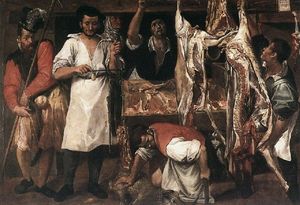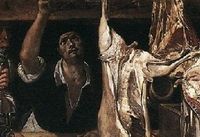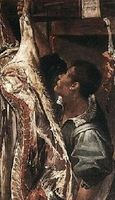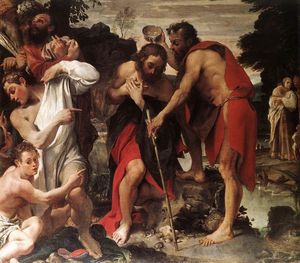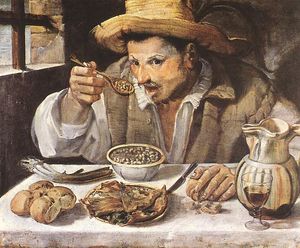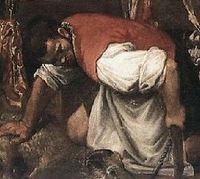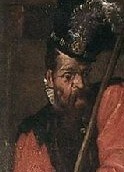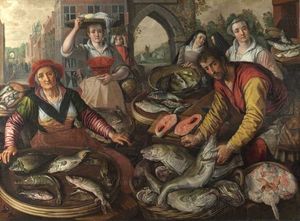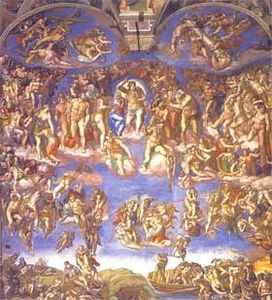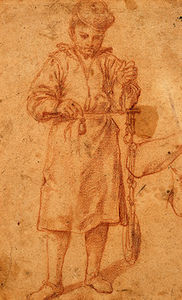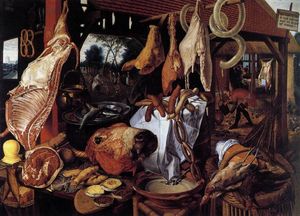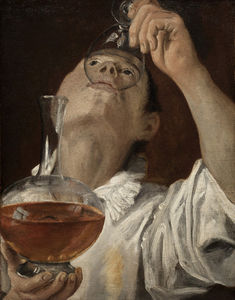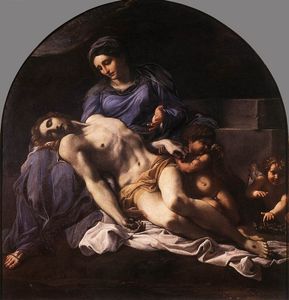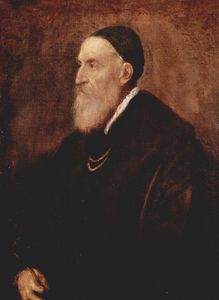The Butcher's Shop
- Date of Creation:
- circa 1580
- Height (cm):
- 185.00
- Length (cm):
- 266.00
- Medium:
- Oil
- Support:
- Canvas
- Subject:
- Scenery
- Art Movement:
- Baroque
- Created by:
- Current Location:
- Oxford, United Kingdom
- Displayed at:
- Christ Church Picture Gallery
- Owner:
- Christ Church Picture Gallery
- The Butcher's Shop Page's Content
- Story / Theme
- Inspirations for the Work
- Analysis
- Critical Reception
- Related Paintings
- Artist
- Art Period
- Bibliography
The Butcher's Shop Story / Theme
Annibale Carracci's The Butcher's Shop is a genre scene: it does not represent a specific subject from literature or mythology, but simply a scene from everyday life. Here, Carracci shows the four main activities that take place in a butcher's shop: slaughter, the dressing of the meat, the weighing of the meat and finally the purchase by the consumer.
The circumstances surrounding the execution and commission of Carracci's The Butcher's Shop are unknown. Some art historians have speculated that the painting is Carracci's personal manifesto for the worthiness of the laboring class.
Annibale's father was a humble tailor and his uncle Vincenzo was a butcher, the lowliest of professions in Baroque Italy. One art historian claims to have identified the members of the Carracci family in the figures of the butchers (Annibale Carracci, Agostino and Ludovico), and claims that The Butcher's Shop is thus Annibale's manifesto of the innate nobility of butchers and the Carracci family.
Art historians have since dismissed the portrait theory, although the idea that the artist's familial context informs the composition is a likely one.
Other theories hold that The Butcher's Shop could have been executed for the powerful Butcher's Guild of Bologna, or for the influential and wealthy Canobi family, who owned a chain of butcher and livestock shops in the city.
Around the same time this work was painted, Annibale had executed another painting for the Canobis, a Baptism of Christ for their chapel in San Gregorio.
The Butcher's Shop Inspirations for the Work
Like another of Carracci's paintings, The Bean Eater, this work is an early example of Italian genre painting and a canvas of this size was exceptional for this subject during this time.
Carracci's depictions of mundane scenes were influenced by Vincenzo Campi and Bartolomeo Passarotti and The Butcher's Shop was actually originally attributed to Passarotti.
It's believed that Carracci used family members as models for this piece and x-rays of the work have shown that major alterations to some figures were made by the artist.
The Butcher's Shop Analysis
As with most of his paintings, Carracci's preparation for The Butcher's Shop was extensive. Sketches as well as a smaller painting of the same theme served as studies for the larger composition.
Composition:
Carracci's early works are inculcated with an unprecedented naturalism. Here, the precisely depicted meats as well as the realistic poses of the butchers bespeak an intent observation of nature.
The boyish model is most likely a workshop apprentice and his pose is carefully studied. Carracci's butchers are depicted as dignified, upstanding men, not dirty, mentally-challenged laborers. Their aprons are spotlessly white (unlike the dingy gray of Passerotti's butchers) and their poses are graceful and dignified. They don't engage with the viewer, but are instead absorbed in their work.
Further emphasizing the high status of his figures, the pose of the kneeling butcher in the center of the composition is a direct quotation from Raphael's The Sacrifice of Noah which was known to Carracci from an engraving.
In Carracci's composition, it is the customers who are the artist's target, not the butchers. Note how the Swiss halberdier awkwardly juggles his staff as he reaches for his change across a surprisingly prominent codpiece, suspiciously glaring at the butcher to make sure he is weighing the meat correctly.
The old crone buying meat in the back of the composition is similarly ridiculous. She gazes at the butcher fetching her order with an almost lascivious avidity. According to Wind, the old woman was a figure often associated with lust in contemporary Italian culture.
Color palette:
In The Butcher's Shop as in other early works, like The Bean Eater, Carracci employs a sober palette limited to earth tones. The fleshy reds and browns of the meat dominate the entire canvas, with the exception of the bright white of the butchers' smocks.
Brushwork:
Like his other paintings from the 1580s, here Annibale Carracci adopts a freer, rougher brushstroke, better suited to the depiction of this realistic subject matter than the smooth, carefully controlled and polished brushwork of the Mannerists.
The artists' use of bold paint-strokes, particularly for the carcass, emphasizes a shift in painting and set the tone for the Impressionist movement over 250 years later.
The Butcher's Shop Critical Reception
With The Butcher's Shop, Carracci once again takes a pre-existing theme and turns it into something completely new. He does away with the satire, lasciviousness and moralizing intent of the earlier versions, and instead executes a painting which portrays the actual workings of a Butcher's Shop in an objective, dignified light.
Theologians often drew on the language of the Bible to refer to dangerous consumer habits which stem from a vast choice of products as 'temptations of the flesh,' and these often inspire somewhat graphic portrayals of butchers' shops.
Like Aertsen and Beuckelaer's art, in the 16th century these are not yet authentic still-lifes but rather point towards materialization intrinsic in this genre.
There remains a great deal of mystery surrounding the true meaning of The Butcher's Shop. At the end of the sixteenth century, the Carracci family were reformers of Italian art and advocated a return to classicism and rejected the Mannerist style. Thus, it's possible that this work is an expression of these aims, which entailed drawing from the live model, or viva carne, which translates as "living flesh" and "red meat" in Italian.
Yet, some have pointed to religious implications in this work; the butcher weighing the flesh is seen to be resembling St Michael weighing the souls in paintings of the Last Judgment and the slaughter of a lamb, and his prominence in this work, may signal Christ, as the lamb of God.
Others argue that The Butcher's Shop composition is that of a stage show and is a "thematic representation of a literary motif from a picaresque tale."
The Butcher's Shop Related Paintings
The Butcher's Shop Artist
Annibale Carracci's style is sometimes seen by contemporary viewers as conventional, even stiff or boring. In his own time, however, his paintings were shockingly innovative. Not only did he help to usher in a new style of naturalism into Baroque art, but Annibale also pioneered brand-new subjects in Italian art, like genre scenes and the idealized landscape.
When Annibale Carracci began executing paintings like The Butcher's Shop, genre paintings were virtually unknown in Italy. A genre painting is a scene of ordinary people carrying out everyday activities.
Especially popular in northern Europe, genre scenes were traditionally reduced to the background of a picture dominated by a different, more suitable theme and typically served to enforce some moral message.
In the 16th and 17th centuries, just as poets began to write in the vernacular, artists began to paint in a more natural, realistic idiom. The painted scenes inspired by their surroundings instead of from the Bible or arcane Greco-Roman texts.
Genre scenes abounded in Northern art during the 16th century but Annibale Carracci, with his enthusiasm for naturalism and study from life, was one of the first artists to popularize the genre in Italy.
Annibale Carracci is the forgotten artist of the 17th century but his art was extremely influential in the course of Baroque art. His style was revolutionary for its unprecedented naturalism and careful, objective study from life.
It's a credit to Carracci that artists such as Poussin, Bernini and Rubens have admired his work and many of his assistant and pupils went on to become renowned artists in their own right, including Giovanni Lanfranco, Domenichino and Guido Reni.
The Butcher's Shop Art Period
The Baroque style originated in Italy and its pioneers include great artists such as Michelangelo and Tintoretto. Baroque art focused on impersonal and generic works with an animated and energetic mood.
The success of this art genre was promoted by the Roman Catholic Church and the aristocracy, the latter of which saw Baroque art as a means of demonstrating wealth and power.
Annibale Carracci began painting at the wane of Mannerism and at the peak of the Counter-Reformation, just after the thinkers behind the Council of Trent made public their call for a new art: an art of simplicity, clarity and a direct appeal to the emotions. Carracci took these criteria to heart and almost single-handedly molded what would become the art of the Italian Baroque.
Italian Baroque art was not widely different to Italian Renaissance painting but the color palette was richer and darker and the theme of religion was more popular. It was Carracci who managed to blend an unprecedented naturalism with the idealized perfection of classical and Renaissance art, thus creating the style that would dominate Italy for an entire century.
Consequently, Carracci's style has been called "eclectic": his influences are incredibly varied, ranging from local northern Italian artists to Venetian Renaissance painters like Titian and Tintoretto to Renaissance masters Michelangelo and Raphael, to the works of classical antiquity.
The Butcher's Shop Bibliography
To read more about Annibale Carracci, choose from this comprehensive list of recommended sources.
• Bohlin, Diane de Grazia. Prints and Related Drawings by the Carracci Family: A catalogue raisonée. National Gallery of Art, 1979
• Boschloo, A. W.A. Annibale Carracci in Bologna: Visible Reality in Art After the Council of Trent. Trans. R. R. Symponds. A. Schram, 1974
• Dempsey, Charles. Annibale Carracci and the Beginnings of Baroque Style. Augustin, 1977
• Dempsey, Charles. Annibale Carracci: The Farnese Palace, Rome. New York: George Braziller, 1995
• Freedberg, S. J. Circa 1600: A revolution of style in Italian painting. Harvard University Press, 1983
• Goldstein, Carl. Visual Fact over Verbal Fiction: A study of the Carracci and the criticism, theory, and practice of art in Renaissance and Baroque Italy. Cambridge University Press, 1988
• Lagerlöf, Margaretha Rossholm. Ideal Landscape: Annibale Carracci, Nicolas Poussin, and Claude Lorrain. New Haven: Yale University Press, 1990
• Posner, Donald. Annibale Carracci: A study in the reform of Italian painting around 1590. Phaidon, 1971
• Wittkower, Rudolf. The Drawings of the Carracci in the Collection of Her Majesty the Queen at Windsor Castle. Phaidon Press, 1952

